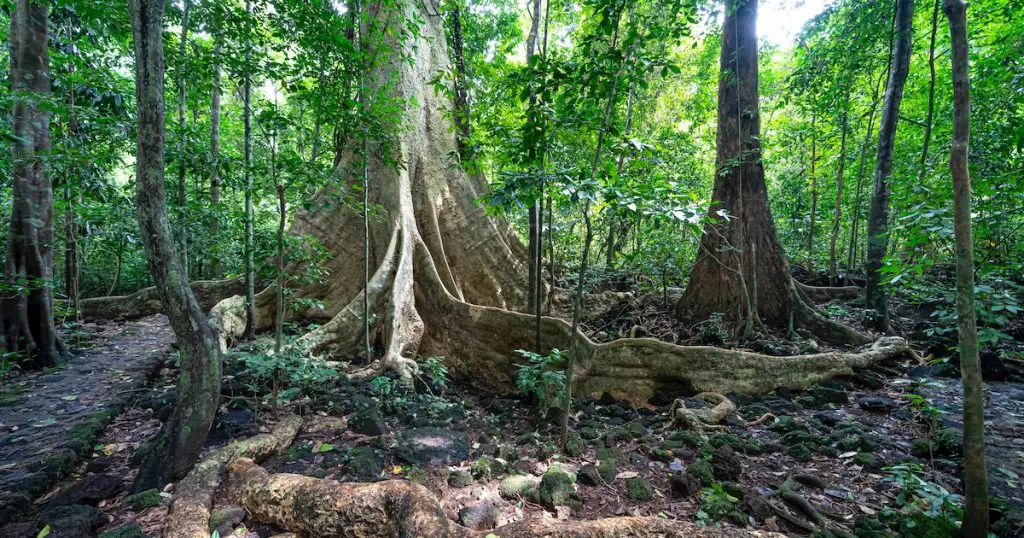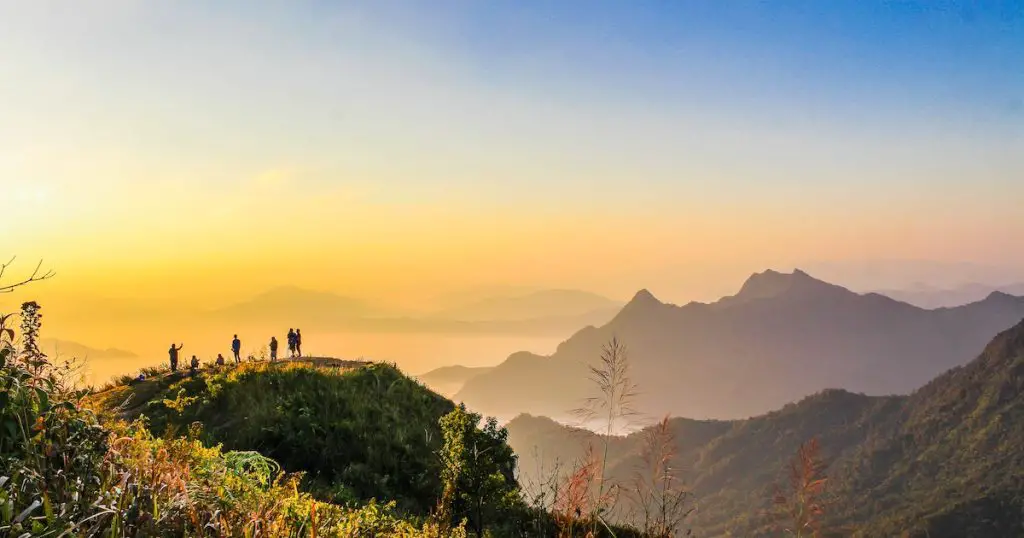Nestled within the heart of Arizona, the Prescott National Forest spans a vast expanse, covering over 1.25 million acres of pristine wilderness. Known for its scenic beauty, this verdant space holds more than just aesthetic wonders.

It’s a critical economic linchpin for the region. In this article, we’ll explore the multifaceted economic role of Prescott National Forest, uncovering its significance from both a historical and present-day perspective.
Historical Economic Role
The roots of Prescott National Forest run deep. Before modern industries took the helm, native peoples and early settlers recognized the bounty and opportunities this forest presented.
Ancient Native American tribes, such as the Yavapai, depended on the forest’s resources for sustenance and survival. They thrived through hunting, gathering, and utilizing the forest’s resources for tools and shelter.
The forest’s role shifted with the arrival of early settlers, who looked to the land primarily for resource extraction and trade. Timber was among the primary resources, with the dense forests providing ample wood for construction, fuel, and sale.
Natural Resources & Revenue
Prescott National Forest, with its vast expanse, is a reservoir of natural resources. Timber, minerals, and freshwater sources dot its landscape, playing a pivotal role in driving regional economic growth. These resources, when harnessed sustainably, generate significant revenue, both through direct sales and the industries they support.
Timber logging, for instance, not only brings in revenue from wood sales but also propels the local woodworking and paper industries. Similarly, freshwater streams benefit agriculture and aquaculture.
These resources, while invaluable on their own, also act as catalysts, drawing in industries and businesses keen on capitalizing on the forest’s bounty. The revenue generated from these activities amplifies Prescott National Forest’s standing as an economic powerhouse in the region.
Timber Industry
Historically, timber was an enormous source of revenue and employment. Lumberyards dotted the perimeter, processing the wood to be used in rapidly expanding settlements. Today, although the scale has shifted, the forest still offers a plethora of timber-related opportunities.
Modern operations, balancing economic interests with sustainability, continue to benefit the local economy. According to the USDA Forest Service, responsible timber harvesting contributes millions annually.
The impact of the timber industry doesn’t stop at direct sales. It spurs growth in ancillary industries, from transportation to carpentry.
Mineral Extraction
Prescott National Forest is not just rich above the ground, but also below. Its lands are known to house valuable mineral deposits. Over the decades, mining has ebbed and flowed in significance. But, even today, select areas within the forest allow for mineral extraction, adhering to strict environmental guidelines.
This industry, while not as pronounced as timber, still plays a role in the forest’s economic tale. The extracted minerals, from gold to quartz, find their way into various industries, adding to the GDP.
Water Resources
Water is life. Beyond its obvious ecological significance, water from Prescott National Forest plays a pivotal role in local agriculture and urban centers. The forest’s watersheds supply crucial water to farmlands, enhancing agricultural yield.

The Economic Value of Watersheds highlights how areas like the Prescott National Forest ensure regional agricultural viability and economic stability.
Moreover, watershed conservation is not just an ecological pursuit; it’s an economic one. Protecting the purity and sustainability of these water resources has long-term economic implications, from preventing costly infrastructural damages to ensuring a steady water supply.
Recreation and Tourism
Prescott National Forest stands as a beacon for nature enthusiasts and adventure seekers alike. Its diverse landscapes, from serene meadows to rugged terrains, beckon millions annually, fueling a thriving tourism industry.
Visitors, lured by hiking trails, camping spots, and breathtaking vistas, bring with them a surge of economic activity. Local businesses, especially the hospitality and retail sectors, benefit immensely from this influx. Beyond direct revenues from permits and fees, the tourism ripple effect amplifies as visitors spend on accommodation, food, and local crafts.
Thus, recreation and tourism in Prescott National Forest not only enrich the soul but significantly bolster the local economy, making it an indispensable asset to the region.
Direct Contributions
Visitors to the forest often engage in activities that require permits or entrance fees. These direct revenues feed back into the maintenance and enhancement of the forest. However, the economic influence extends beyond park boundaries.
Local businesses, particularly hotels, restaurants, and shops, experience booms, especially during peak seasons. According to a report by Arizona Tourism, forest-related tourism has a multiplicative effect on local economies.
Indirect Contributions
Recreation isn’t just about immediate spending. The presence of such a vast, accessible forest elevates property values in adjacent areas.
Furthermore, as visitors spend on various services, local tax revenues see a spike. This cycle ensures a sustained, indirect economic benefit from tourism.
Biodiversity and its Economic Impacts
Prescott National Forest boasts a rich tapestry of biodiversity, with its vast array of flora and fauna painting a vibrant ecological picture. This biological wealth isn’t just an ecological treasure but an economic asset too.
The unique species found within the forest have led to commercial opportunities, from pharmaceuticals harnessing the medicinal properties of native plants to specialized markets eager for rare fruits or herbs.

Furthermore, this biodiversity ensures robust ecosystem services, such as water purification and soil enrichment, which indirectly bolster agricultural and health sectors. In essence, the biodiversity of Prescott National Forest is not merely an environmental accolade but a cornerstone of its multifaceted economic contribution to the region.
Flora & Fauna
The Prescott National Forest is home to an array of native species. Some of these, like medicinal herbs or unique fruits, have significant market value.
Industries, ranging from pharmaceuticals to gourmet foods, benefit from these specialty forest products. For instance, the American Herbal Products Association often emphasizes the economic potential of wild herbs.
Ecosystem Services
Nature has a way of giving back. Forests, particularly ones as expansive as Prescott, offer invaluable ecosystem services. They purify the air, ensuring healthier living conditions. Their vast tracts of land act as water filters, ensuring cleaner water supplies.
Moreover, the rich soil, aided by the forest’s organic decay, promotes soil fertility. This is crucial for the agricultural endeavors around the forest.
Employment Opportunities
Prescott National Forest is more than just a haven of nature; it’s a hub of livelihood for many. The forest, with its sprawling expanses and rich resources, is a catalyst for diverse job opportunities. From rangers who oversee its vast stretches to tour guides enlightening visitors about its wonders, the direct employment scope is vast.
Furthermore, its presence spurs growth in the surrounding communities, driving jobs in local businesses, from cozy inns to bustling eateries. Additionally, the sustainable extraction of its natural resources — be it timber, minerals, or unique flora — provides employment in industries tied closely to the forest’s bounty.
In essence, Prescott National Forest is a significant employer in the region, directly and indirectly shaping the economic and social fabric of the communities around it.
Direct Employment
From forest rangers to guides, the forest directly employs hundreds. These roles, essential for the upkeep and promotion of the forest, represent steady, often long-term employment opportunities.
The ripple effect of the forest’s economic activities creates jobs in the surrounding communities. Whether it’s seasonal jobs catering to the influx of tourists or roles in industries that rely on the forest’s resources, indirect employment opportunities abound.
Research and Education
Knowledge is power, and the Prescott National Forest serves as a living laboratory. Educational institutes often seek grants to conduct research within the forest. This not only enhances scientific knowledge but brings funding into the region.
Moreover, educational tours and programs, often integrated into school curriculums, also offer economic opportunities, from transportation to catering.
Challenges & Opportunities
The Prescott National Forest stands at the intersection of rich heritage and the pressing demands of modern times. On one hand, it faces challenges from environmental threats such as climate change, invasive species, and overuse in certain areas.
These challenges directly influence the forest’s health and the economic activities rooted in its expanse. On the other hand, these pressing issues also present opportunities. There’s a rising global emphasis on sustainability and eco-responsibility, creating avenues for eco-tourism, sustainable resource management, and innovative conservation efforts.
Balancing the immediate economic gains with the forest’s long-term health is pivotal, and in this delicate balance lies the potential for innovation, job creation, and the continued prosperity of the region.

Environmental Threats
Climate change, with its unpredictable patterns, poses threats to the forest’s health. While this has environmental implications, the economic stability of industries relying on the forest is also at stake.
Opportunities are aplenty for new industries to flourish, leveraging the forest’s resources. Sustainable economic models are being explored, ensuring the forest’s longevity and continued economic contribution.
Frequently Asked Questions:
In this section, we will be delving into some of the most common inquiries and curiosities that surround our topic.
How much revenue does Prescott National Forest generate annually?
While exact figures can vary, annual revenues, when factoring in tourism, resource extraction, and indirect contributions, run into millions.
Are there any new industries poised to take advantage of the forest’s resources?
With the advent of sustainable practices and eco-conscious consumers, industries like eco-tourism, organic agriculture, and sustainable craft businesses are on the rise. The forest’s vast biodiversity also opens doors for bio-research firms.
How does the forest’s economic impact compare to its environmental significance?
The environmental significance of Prescott National Forest is undeniable. It serves as a habitat, purifies air, and conserves water. But economically, its influence is equally impactful. From job creation to boosting the GDP through various industries, the forest is a linchpin in the local economy.
What initiatives are in place to ensure sustainable economic growth?
Several initiatives aim at balancing economic pursuits with ecological sustainability. Collaborations with environmental agencies ensure that resource extraction is sustainable. Moreover, there’s a significant push towards promoting eco-tourism, which respects the forest’s natural balance while contributing economically.
Conclusion
The Prescott National Forest isn’t just a haven for nature lovers; it’s an economic powerhouse. From the time of the Native Americans to present-day industries, the forest has consistently played a pivotal role in shaping the economic landscape of the region.
Be it through direct resource extraction, tourism, or even the less tangible ecosystem services, Prescott National Forest continues to underscore the intricate bond between nature and economy. As we move forward, it serves as a poignant reminder of the need for sustainable growth, where economic aspirations and environmental stewardship walk hand in hand.



Leave a Comment
You must be logged in to post a comment.